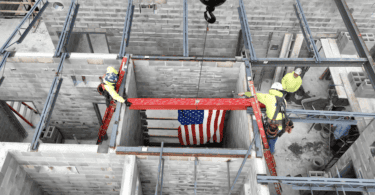by Gerard Georges and Jay Verspyck
As architects at Build Health International (BHI), a healthcare design and construction nonprofit committed to providing infrastructure solutions in low- and middle-income countries, designing facilities that inspire trust is at the heart of our work. Over the past decade, BHI has worked on over 200 healthcare projects in 28 countries, but the importance of instilling trust through design has never been greater than it is for the Maternal Center of Excellence (MCOE) in Sierra Leone.

Ample shaded outdoor waiting areas are designed to provide space for patients and their families to wait comfortably and convene while visiting the MCOE.
In 2015, Sierra Leone was at the height of the Ebola epidemic and was also the country with the highest maternal mortality rate in the world. Throughout the epidemic, hospitals became vectors for the disease, discouraging mothers from seeking prenatal care or visiting the hospital to give birth. These dueling burdens, in addition to the lingering effects of a decade-long civil war, led to a widespread distrust of the healthcare system. Today, Sierra Leone still holds one of the highest mortality rates in the world where one in 20 women face a lifetime risk of dying in pregnancy and childbirth.
Aiming to restore trust and provide dignified care, while simultaneously addressing the barriers to safe maternal healthcare across Sierra Leone, Partners in Health (PIH) teamed up with BHI to design and build the MCOE. To address and combat long-standing distrust, every aspect of the MCOE has been intentionally designed with healing, privacy, and comfort in mind.

In planning the MCOE design, BHI held clinical stakeholder meetings to gather feedback and suggestions from local hospital staff. Pictured: BHI senior architectural designer, Allison Denisky, walks through an early design on the MCOE in February 2020. / Photo courtesy of BHI
The MCOE will feature generous outdoor spaces including courtyards, a waiting pavilion, and kitchens, which will create a space for patients and their families to wait comfortably and decompress. These large, shaded outdoor areas will also serve a dual purpose as gathering spaces for clinical staff to facilitate community education and engagement programs. Placing an emphasis on social spaces will foster a sense of shared experience, a key ingredient to building trust.
Developed through community led discussions and clinical stakeholder workshops, the hospital’s design takes cultural context into consideration. Because not all patients will be literate, the MCOE will integrate a way-finding system that relies on colorful mosaics instead of words. The mosaics are inspired by local artistry, as many local hotels and restaurants repurpose broken tiles to create artwork. The beautiful and intuitive way-finding system will put patients at ease while navigating the 10-building hospital.
Learning from the lessons of Ebola and building on standard care practices, MCOE isolation rooms will each contain an entrance that opens directly to the exterior of the building. These entrances will ensure that sick patients won’t have to be wheeled through the hospital, reducing the possibility for spreading disease. The design also incorporates passive airflow and ventilation, important features for not only ensuring temperature control but also reducing the spread of airborne diseases.
Restoring trust in Sierra Leone’s healthcare system won’t happen overnight, but it will start by reducing preventable maternal deaths through high-quality infrastructure. It will start by creating a welcoming, safe, and comfortable environment for all mothers to seek care. It will start with the MCOE.
Gerard Georges is director of architecture, and Jay Verspyck is director of design, at Build Health International.













